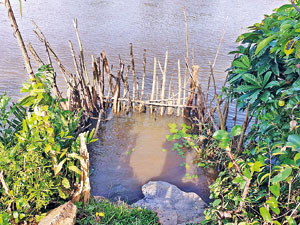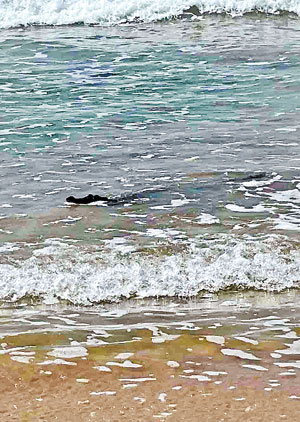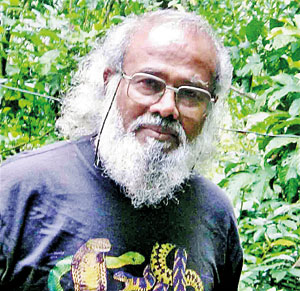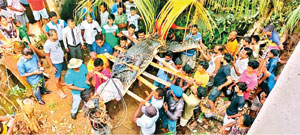News
Risks from crocs higher during mating season
View(s):By Malaka Rodrigo
Piladuwa is a hamlet in Matara close to where the famous poet ‘Gajaman Nona’ lived. Piladuwa ela flows through the village and crocodiles inhabit this stream.
This stream links with the Nilwala River, so occasionally, oversized crocs have been observed. One such giant croc had been seen for several days and the villagers trapped it on the night of March 5. They then informed the Department of Wildlife Conservation’s Mirissa office. Officers relocated it.

Crocodile Excluding Enclosure (CEE), and right a CEE in disrepair. Pix by Dinal Samarasinghe
“The crocodile captured was 14.5 ft long and a well-grown male salt-water crocodile,” said M P Sanjeewa, wildlife ranger, Mirissa regional office. As crocodiles are important to the ecosystem, the croc had been released upstream in the Nilwala. But Piladuwa residents were not pleased.
Mr Sanjeewa said the translocations are not a solution as males are territorial and when a croc is removed, another one takes over. There are reports that already another crocodile is roaming in the area, he said.
Malindu Gajaweera, a Matara Provincial Councillor said Piladuwa villagers are at risk from crocodiles, and is urging assistance.
Sri Lanka has two species of crocodile namely the mugger crocodile (Crocodylus palustris) – ‘hala kimbula’ and the salt-water crocodile (Crocodylus porosus) ‘geta kimbula’. The Nilwala, Walawe, Gin, Kelani rivers and estuaries along the southern and western coasts are home to the salties. But the conflict with humans is worst in the Nilwala where several humans, as well as crocodiles, are killed annually.
Six months ago, a fisherman who stepped into the water from the Malimbada area was killed and only parts of his remains were found.
Some crocs end up being killed. One that had been killed was about 13.5 feet and its carcass was badly decayed. DWC officers used a backhoe to remove it from the water. Another croc died from wounds caused by the hook used to catch it, Mr Sanjeewa told the Sunday Times.

Crocodile in the sea near Ahangama. Pic courtesy DWC
Several weeks ago, a crocodile was captured from the sea off Ahangama. Another crocodile was frequently seen in the sea.
According to Hikkaduwa Wildlife office, they get several calls a week these days informing them of the presence of crocodiles in the sea.
Salties, as a rule, are solitary animals. Adult males dominate their territory and will not hesitate to kill an intruder. During the breeding season, mature males move in search of a female, said Dr Anslem De Silva, regional chairman of the crocodile specialists group of the IUCN, South Asia and Iran.
Breeding season is February-April and it corresponds with the recent activity, Dr De Silva told the Sunday Times.
Dr De Silva said that saltwater crocs survive at sea where they can excrete excess salt in the body from ‘salt glands’ (modified salivary glands). The coastal migration of crocs is also common where they migrate from one canal or river to another via the sea. This phenomenon is known, and publications over 100 years old have made references to this.
He said the sea route for crocs is safer considering the hindrances such as “houses, (road) traffic, long queues for gas, petrol, and worse, ‘udghoshana’’’.
Big males generally move further, even more than 100 kilometres sometimes when looking for females. Dr De Silva said saltwater crocs have been recorded several 100 km out to sea. On one occasion a saltie from Sri Lanka had swum to the Maldives. Also, a 9-foot saltie from Sri Lanka, which had got entangled in the nets of South Indian fishermen, is now in a Madras crocodile farm.
Dinal Samarasinghe, another herpetologist who has been surveying crocodiles of the Nilwala since 2015, says the river has a healthy crocodile population and they are found 40-50 kilometres upstream from the river mouth. He said human deaths had been caused largely because safety has been ignored.
Having Crocodile Excluding Enclosures (CEE) was the main method to ensure safety of people using rivers, Mr Samarasinghe said adding that on his regular surveys he noted that many CEEs upto Akuressa needed urgent maintenance.
 Pioneering herpetologist Anslem leads regional panel Pioneering herpetologist Anslem leads regional panel Dr Anslem De Silva who is considered the father of modern herpetology of Sri Lanka, was recently appointed as regional chair of the IUCN/SSC snake specialist group for South Asia. Dr De Silva studies reptiles, especially snakes, crocodiles, and amphibians. He has produced a record number of publications of over 400. He has also groomed a number of young herpetologists in the country and organised a number of herpetological events in Sri Lanka. He is the regional chair of the IUCN/SSC crocodile specialist group for South Asia. | |

Crocodile caught in Piladuwa. Pic by Krishan Jeewaka Jayaruk
The best way to say that you found the home of your dreams is by finding it on Hitad.lk. We have listings for apartments for sale or rent in Sri Lanka, no matter what locale you're looking for! Whether you live in Colombo, Galle, Kandy, Matara, Jaffna and more - we've got them all!

